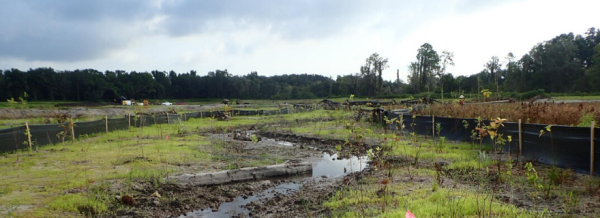Hydraulic Carving Creates New Habitat with Water Flow, not Bulldozers

Rather than concrete or rip-rap, managers used branches and root wads to direct the streams flow. Photo by Vicki Parsons
It’s almost impossible to believe that the meandering stream gently flowing through a peaceful valley just didn’t exist this time last year.
Stallion Hammock at the Balm Boyette Scrub Nature Preserve in southeastern Hillsborough County had been a series of deep pits separated by towering mounds of left-over dirt. Strip-mined for phosphate in the 1960s before reclamation was required, the stream that ran through the 25-acre restoration site had been destroyed.
“It was a blank slate,” recalls Janie Hagberg, chief professional engineer for the Southwest Florida Water Management District’s SWIM (Surface Water Improvement and Management) Program, who led the restoration.
But rather than using heavy equipment to build the stream bed, Hagberg and her team used a new technology called “hydraulic carving” to recreate the natural design. “We mimicked the natural process that would have taken decades to accomplish, and created the stream bed in just six to eight weeks.”
John Kiefer, principal water resources engineer in the Lakeland office of Wood, an international consulting firm, is a pioneer in the field of hydraulic carving. Three projects he’s worked on in Central Florida may be the first of their kind in the world.
“Water is more efficient than big pieces of yellow equipment,” he quips.
Water was pumped from the abandoned pits to a 1,500-foot-long valley at 2,000 gallons per minute in a recirculating system. Over a period of several weeks, it naturally carved a stream bed as it flowed back to the pits.
 Engineers redirected some of the flow, but using natural materials like root wads and logs to protect banks or force the water to slow down, not the more typical concrete structures.
Engineers redirected some of the flow, but using natural materials like root wads and logs to protect banks or force the water to slow down, not the more typical concrete structures.
Along with the newly dug stream bed, the restoration project smoothed out the pits and piles of dirt to create a 10-acre pond with shallow shelves where sandhill cranes already are nesting, half-hidden from the shore by a stand of native canna lilies.
Deep pits left over from phosphate mining were resculpted into shallow ponds that already host a nesting pair of sandhill cranes.
All together, nearly 200,000 plants were installed on the 25-acre site, including water plants for the pond as well as pines, oaks, elms and maples in upland areas.
Why hydraulic carving works
“Water is smarter than I am,” Kiefer said. “And it’s persistent — it does exactly what it wants to do.”
Ironically, the catalyst for the concept was Kiefer’s son playing in a sandbox with a hose. “He was carving a stream with the water and I thought ‘why not use water instead of conventional equipment?’”
Flume studies conducted by the U.S. Army Corps of Engineers and the University of Colorado validated the idea so Kiefer tried it with a reclamation project for Mosaic. It worked so well that he did another project for Mosaic and then this one for SWFWMD.
“To the best of my knowledge, these are the only hydraulic carvings in the nation,” he said. “I conduct a lot of research and I haven’t seen anything like it in the literature or heard about it at any conference.”
If you go: The Balm Boyette Scrub Nature Preserve, located at 15102 County Road 672 in Wimauma, was purchased through Hillsborough County’s Environmental Lands Acquisition and Protection Program and the Florida Conservation and Recreation Lands Program. The 5,723-acre site is best known for 25 miles of mountain biking trails. It also contains 800 acres of undisturbed habitat where protected species, including the Florida golden asters, Florida scrub jays, indigo snakes and gopher tortoises, can be found.


 Advertising
Advertising